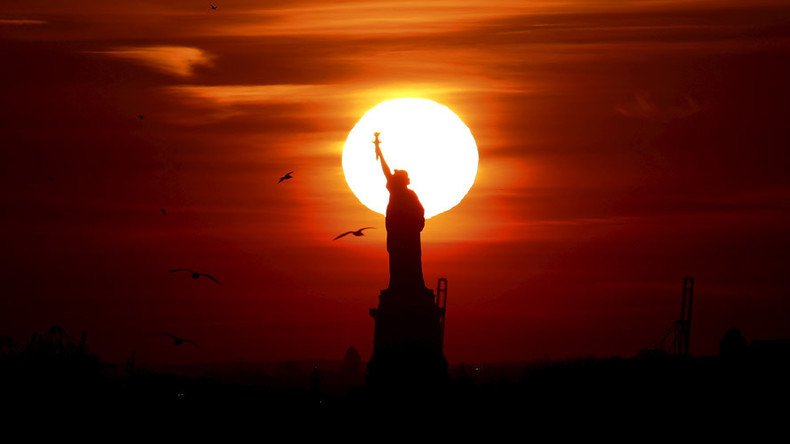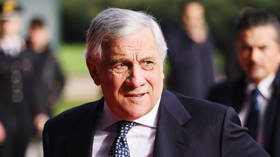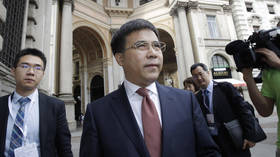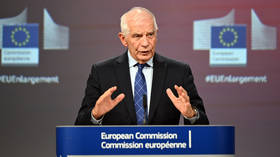Statue of Liberty, other world sites, vulnerable to 'threat multiplier' climate change – report

Increasing temperatures, rising sea levels and intensifying weather are just some of the threats to the Statue of Liberty, Yellowstone National Park and Mesa Verde National Park, as well as other World Heritage Sites in dozens of countries, a UN report found.
“The Statue of Liberty is probably the most recognizable statue on the planet and it stands as one of the world’s most potent symbols of freedom…but as solid and invulnerable as…itself seems…the site…is actually at considerable risk from...sea-level rise, increased intensity of storms and storm surges,” stated the report World Heritage and Tourism in Changing Climate, released on Thursday by UNESCO, the United Nations Environment Program (UNEP) and the Union of Concerned Scientists.
Statue of Liberty among World Heritage Sites threatened by #climatechange, UNESCO warns https://t.co/tq5PEpO9fopic.twitter.com/3sk15WTq96
— The Boston Globe (@BostonGlobe) May 27, 2016
The report said the consequences of climate change could damage or destroy the Statue of Liberty along with 30 other natural and cultural World Sites such as Venice, Stonehenge, the Galapagos Island, South Africa’s Cape Floral Region, the city of Cartagena, Colombia and the Shiretoko peninsula in Japan. Twenty-nine countries are impacted.
Dozens of World Heritage Sites at risk from climate change: @UNEP/@UNESCO/@UCSUSA report https://t.co/kc3RAdPZcJpic.twitter.com/Y2FrnksA8q
— Achim Steiner (@ASteiner) May 27, 2016
World Heritage sites are tourist destinations, and tourism is one of the world’s largest and fastest-growing economic sectors, responsible for 9 percent of gross domestic product globally and providing one in 11 jobs, but climate change threatens that and more.
“Climate change is a threat multiplier and will increase vulnerability and exacerbate other stresses including but not limited to pollution, conflict over resources, urbanization, habitat fragmentation, loss of tangible cultural heritable and the impact of unplanned or poorly managed tourism,” stated the report.
When Hurricane Sandy hit the New York City in October 2012, it destroyed more than 75 percent of Liberty Island in New York Harbor through flooding, damaging the island’s infrastructure, and forcing it to close for nine months, according to the report. The Liberty Monument is at an extremely low elevation of the island and makes it vulnerable to storms.
“Water levels at Battery Park…reached nearly 4.3 meters…with wave heights [of] 9.91 meters in New York Harbor during the storm…Hurricane Sandy closed Liberty Island for nine months, seriously damaging or destroying much of the infrastructure on the island including electrical, water, sewage, security and telephone systems,” according to the report.
“Repairs to the island after Sandy included replacing an 84-metre dock, …new paving blocks to rebuild the walkways…electrical systems had to be raised as much as 6 meters above sea level.”
Venice, Stonehenge among World Heritage sites threatened by climate change https://t.co/n6ESFOMNiypic.twitter.com/GFacn5jAMv
— CBC News (@CBCNews) May 27, 2016
The Statue of Liberty, which is valued at more than $1.5 billion, was re-fitted with an energy-efficient, light-emitting diode system above ground and flood levels.
“[T]he intangible cost of future damage…incalculable…the damage was extensive and tourism…had to close for many months…but the lessons learned from its recovery can provide a model for other vulnerable coastal sites,” said the report.
Equally vulnerable is Yellowstone National Park, which covers about 5,592 square miles (9,000 square kilometres) in the Northern Rocky Mountains.
“[The] park forms the core of one of the planet’s last remaining, mostly intact large-scale temperate ecosystems…scientists…have major concerns about the growing signs of climate change in the park…temperatures…have risen by 1.17 degree Celsius…warming is…causing the winter in the park to become shorter, with less snowfall and snow staying on the ground less often…snow totals and the timing of snowmelt effect the rivers and streams of the park,” stated the report.
“Biologist are predicting a 26 percent decrease in native cutthroat trout because of warmer temperatures…40 percent of wetlands…could be lost…frogs…may be under threat…[as well as] swans…cranes...with rising temperatures…fires season has lengthened from five months in the 1970s to seven months today…predicted to increase…by 600 percent or more.”
Eco activists protest BLM’s plans to cut down forests in Oregon, cry climate change riskshttps://t.co/jF9CZSvEqapic.twitter.com/kd7bWKY5ol
— RT America (@RT_America) May 18, 2016
Mesa Verde National Park in Arizona is also on the list of vulnerable sites, which preserves the cultural heritage of many Native American tribes including the Hopi, Laguna and Zuni.
Temperatures are rising in the park and annual rainfall is declining, leading to hotter, drier conditions and a greater number of large wildfires. The archaeological sites are vulnerable to flash floods and erosion that often follows.
“The vulnerability of Mesa Verde’s cultural assets to climate change could have a negative effect on tourism in the park, which attracts about 500,000 visitors a year contributing about $47 million to the local economy,” stated the report. “Damage to archaeological sites and the iconic cliff dwellings could change this, as could more frequent park closures due to large wildfires.”
'I have introduced the most comprehensive climate change legislation.' - Sanders https://t.co/5JNQMwdHZApic.twitter.com/zzE2ZB3hZH
— RT America (@RT_America) April 15, 2016
The report findings come with recommendations which include achieving the goals of the Paris Agreement. Other remedies are sustainable tourism, raising awareness among tourists, better monitoring of Heritage sites for climate change vulnerabilities, preparing disaster response strategies and ensuring that indigenous peoples and local communities are involved.
“As the report’s findings underscore, achieving the Paris Agreement’s goal of limiting global temperature rise to a level well below 2 degrees Celsius is vitally important to protecting our World Heritage for current and future generations,” Mechtild Rössler, director of UNESCO’s World Heritage Centre, said in a news release.
Hulk Hogan, World Heritage sites, and a missing tortoise. What I read this week: https://t.co/7luGFmDuRNpic.twitter.com/NG1ugWshgK
— Michael Halpern (@halpsci) May 27, 2016












